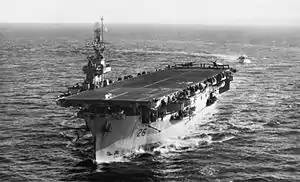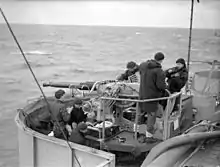HMS Slinger (D26)
USS Chatham (CVE-32) (originally designated AVG-32, then later ACV-32) was built at the Seattle-Tacoma S/Y, Hull #27, Seattle, Washington and transferred to the United Kingdom 11 August 1943 under lend-lease and renamed HMS Slinger (D26). Outfitted by the British as a transport carrier, the ship was mined on 5 February 1944 but returned to service, 17 October. In 1945, she was transferred for service in the Pacific as a fighter carrier and was attached to the 30th Aircraft Carrier Squadron. Following the war, she was returned to United States custody on 27 February 1946 and was sold/converted by Robin Line 21 November 1946 as Robin Mowbray. Moore-McCormack Lines, Inc., purchased Robin Line in 1958. She was scrapped in Kaohsiung Taiwan in 1969-1970.
 HMS Slinger in 1944 | |
| History | |
|---|---|
| Name: | USS Chatham |
| Builder: | Seattle-Tacoma Shipbuilding Corporation |
| Laid down: | 25 May 1942 |
| Launched: | 19 September 1942 |
| Fate: | Transferred to Royal Navy |
| Name: | HMS Slinger |
| Commissioned: | 11 August 1943 |
| Decommissioned: | 12 April 1946 |
| Fate: | Sold as merchant ship, scrapped 1969-1970 |
| General characteristics | |
| Class and type: |
|
| Displacement: | 8,333 tons |
| Length: | 496 ft (151 m) |
| Beam: | 69 ft 6 in (21.18 m) |
| Draught: | 26 ft 3 in (8.00 m) |
| Propulsion: | Steam turbines, 1 shaft, 8,500 shp (6.3 MW) |
| Speed: | 18 knots (33 km/h) |
| Complement: | 646 officers and men |
| Armament: |
|
| Aircraft carried: | 18-24 |
Design and description
The Ruler class were larger and had a greater aircraft capacity than preceding American built escort carriers. They were also all laid down as escort carriers and not converted merchant ships.[1] All the ships had a complement of 646 men and an overall length of 492 feet 3 inches (150.0 m), a beam of 69 feet 6 inches (21.2 m) and a draught of 25 ft 6 in (7.8 m).[1] Propulsion was provided by one shaft, two boilers and a steam turbine giving 9,350 shaft horsepower (6,970 kW), which could propel the ship at 16.5 knots (30.6 km/h; 19.0 mph).[2]
Aircraft facilities were a small combined bridge–flight control on the starboard side, two aircraft lifts 43 feet (13.1 m) by 34 feet (10.4 m), one aircraft catapult and nine arrestor wires.[1] Aircraft could be housed in the 260 feet (79.2 m) by 62 feet (18.9 m) hangar below the flight deck.[1] Armament comprised: two 4"/50, 5"/38 or 5"/51 dual purpose guns in single mounts, sixteen 40 mm Bofors anti-aircraft guns in twin mounts and twenty 20 mm Oerlikon anti-aircraft cannons in single mounts.[1] They had a maximum aircraft capacity of twenty-four aircraft which could be a mixture of Grumman Martlet, Vought F4U Corsair or Hawker Sea Hurricane fighter aircraft and Fairey Swordfish or Grumman Avenger anti-submarine aircraft.[1]
Notes
- Cocker (2008), p.82.
- Cocker (2008), p.79.
References
- Cocker, Maurice (2008). Aircraft-Carrying Ships of the Royal Navy. Stroud, Gloucestershire: The History Press. ISBN 978-0-7524-4633-2.
